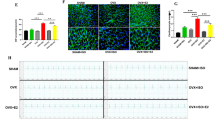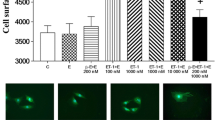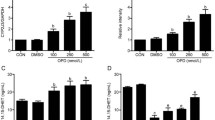Abstract
The present study was aimed to investigate the protective effects of 17β-estradiol (E2) and estrogen receptor α (ERα) on isoproterenol (ISO)-treated H9c2 cardiomyoblast cells. In the present study, we treated H9c2 cells with ISO, a β-adrenergic receptor agonist, to induce myocardiac hypertrophy. Pre-administration of E2 or ERα (induced by doxycycline) and E2 plus ERα significantly prevented ISO-induced increase of cell size and cytosolic calcium accumulation, accompanied with increased mRNA of atrial natriuretic peptide and brain natriuretic peptide. However, ICI-ERs antagonist, and melatonin, a specific inhibitor for ERα, reversed the cardioprotective effects, suggesting that E2 action was mediated through ERα. Further evidences showed that E2 and ERα increased the protein level of GSK3β and protein phosphatase 2a inhibitor 2 (I2-PP2A), which subsequently enhanced the activation of I2-PP2A by disrupting PP2A activity and maintains normal calcium outflow. Collectively, E2 and ERα inhibited hypertrophy by preventing cytosol calcium accumulation and by inhibiting the association between PP2A with Na+–Ca2+ exchanger via GSK3β and I2-PP2A activation.








Similar content being viewed by others
References
Ikeda S, Kong SW, Lu J, Bisping E, Zhang H, Allen PD, Golub TR, Pieske B, Pu WT (2007) Altered microRNA expression in human heart disease. Physiol Genomics 31(3):367–373. doi:10.1152/physiolgenomics.00144.2007
Miya Y, Sumino H, Ichikawa S, Nakamura T, Kanda T, Kumakura H, Takayama Y, Mizunuma H, Sakamaki T, Kurabayashi M (2002) Effects of hormone replacement therapy on left ventricular hypertrophy and growth-promoting factors in hypertensive postmenopausal women. Hypertens Res Off J Jpn Soc Hypertens 25(2):153–159
Post WS, Larson MG, Levy D (1994) Impact of left ventricular structure on the incidence of hypertension. The Framingham Heart Study. Circulation 90(1):179–185
Johnson DB, Dell’Italia LJ (1996) Cardiac hypertrophy and failure in hypertension. Curr Opin Nephrol Hypertens 5(2):186–191
Ares-Carrasco S, Picatoste B, Camafeita E, Carrasco-Navarro S, Zubiri I, Ortiz A, Egido J, Lopez JA, Tunon J, Lorenzo O (2012) Proteome changes in the myocardium of experimental chronic diabetes and hypertension: role of PPARalpha in the associated hypertrophy. J Proteomics 75(6):1816–1829. doi:10.1016/j.jprot.2011.12.023
Yin Q, Yang C, Wu J, Lu H, Zheng X, Zhang Y, Lv Z, Zheng X, Li Z (2016) Downregulation of beta-adrenoceptors in isoproterenol-induced cardiac remodeling through HuR. PLoS ONE 11(4):e0152005. doi:10.1371/journal.pone.0152005
O’Connell TD, Jensen BC, Baker AJ, Simpson PC (2014) Cardiac alpha1-adrenergic receptors: novel aspects of expression, signaling mechanisms, physiologic function, and clinical importance. Pharmacol Rev 66(1):308–333. doi:10.1124/pr.112.007203
Saito S, Hiroi Y, Zou YZ, Aikawa R, Toko H, Shibasaki F, Yazaki Y, Nagai R, Komuro I (2000) Beta-adrenergic pathway induces apoptosis through calcineurin activation in cardiac myocytes. J Biol Chem 275(44):34528–34533. doi:10.1074/jbc.M002844200
Molojavyi A, Lindecke A, Raupach A, Moellendorf S, Kohrer K, Godecke A (2010) Myoglobin-deficient mice activate a distinct cardiac gene expression program in response to isoproterenol-induced hypertrophy. Physiol Genomics 41(2):137–145. doi:10.1152/physiolgenomics.90297.2008
Bers DM (2002) Cardiac excitation–contraction coupling. Nature 415(6868):198–205. doi:10.1038/415198a
Wehrens XH, Marks AR (2004) Novel therapeutic approaches for heart failure by normalizing calcium cycling. Nat Rev Drug Discov 3(7):565–573. doi:10.1038/nrd1440
Steenaart NA, Ganim JR, Di Salvo J, Kranias EG (1992) The phospholamban phosphatase associated with cardiac sarcoplasmic reticulum is a type 1 enzyme. Arch Biochem Biophys 293(1):17–24
Davare MA, Horne MC, Hell JW (2000) Protein phosphatase 2A is associated with class C L-type calcium channels (Cav1.2) and antagonizes channel phosphorylation by cAMP-dependent protein kinase. J Biol Chem 275(50):39710–39717. doi:10.1074/jbc.M005462200
George CH (2008) Sarcoplasmic reticulum Ca2+ leak in heart failure: mere observation or functional relevance? Cardiovasc Res 77(2):302–314. doi:10.1093/Cvr/Cvm006
Hu ST, Liu GS, Shen YF, Wang YL, Tang Y, Yang YJ (2011) Defective Ca(2+) handling proteins regulation during heart failure. Physiol Res Acad Sci Bohemoslov 60(1):27–37
Carr AN, Schmidt AG, Suzuki Y, del Monte F, Sato Y, Lanner C, Breeden K, Jing SL, Allen PB, Greengard P, Yatani A, Hoit BD, Grupp IL, Hajjar RJ, DePaoli-Roach AA, Kranias EG (2002) Type 1 phosphatase, a negative regulator of cardiac function. Mol Cell Biol 22(12):4124–4135. doi:10.1128/Mcb.22.12.4124-4135.2002
Santana LF, Chase EG, Votaw VS, Nelson MT, Greven R (2002) Functional coupling of calcineurin and, protein kinase A in mouse ventricular myocytes. J Physiol Lond 544(1):57–69. doi:10.1113/jphysiol.2002.020552
Zhou XW, Mudannayake M, Green M, Gigena MS, Wang G, Shen RF, Rogers TB (2007) Proteomic studies of PP2A-B56gamma1 phosphatase complexes reveal phosphorylation-regulated partners in cardiac local signaling. J Proteome Res 6(9):3433–3442. doi:10.1021/pr060619l
Liu Q, Hofmann PA (2003) Modulation of protein phosphatase 2a by adenosine A1 receptors in cardiomyocytes: role for p38 MAPK. Am J Physiol Heart Circ Physiol 285(1):H97–H103. doi:10.1152/ajpheart.00956.2002
Molkentin JD, Lu JR, Antos CL, Markham B, Richardson J, Robbins J, Grant SR, Olson EN (1998) A calcineurin-dependent transcriptional pathway for cardiac hypertrophy. Cell 93(2):215–228
Molkentin JD, Olson EN (1997) GATA4: a novel transcriptional regulator of cardiac hypertrophy? Circulation 96(11):3833–3835
Kerkela R, Woulfe K, Force T (2007) Glycogen synthase kinase-3beta—actively inhibiting hypertrophy. Trends Cardiovasc Med 17(3):91–96. doi:10.1016/j.tcm.2007.01.004
Antos CL, McKinsey TA, Frey N, Kutschke W, McAnally J, Shelton JM, Richardson JA, Hill JA, Olson EN (2002) Activated glycogen synthase-3 beta suppresses cardiac hypertrophy in vivo. Proc Natl Acad Sci USA 99(2):907–912. doi:10.1073/pnas.231619298
Michael A, Haq S, Chen X, Hsich E, Cui L, Walters B, Shao Z, Bhattacharya K, Kilter H, Huggins G, Andreucci M, Periasamy M, Solomon RN, Liao R, Patten R, Molkentin JD, Force T (2004) Glycogen synthase kinase-3beta regulates growth, calcium homeostasis, and diastolic function in the heart. J Biol Chem 279(20):21383–21393. doi:10.1074/jbc.M401413200
Lasiuk GC, Hegadoren KM (2007) The effects of estradiol on central serotonergic systems and its relationship to mood in women. Biol Res Nurs 9(2):147–160. doi:10.1177/1099800407305600
Totta P, Busonero C, Leone S, Marino M, Acconcia F (2016) Dynamin II is required for 17beta-estradiol signaling and autophagy-based ERalpha degradation. Sci Rep 6:23727. doi:10.1038/srep23727
Wenger NK (2002) Clinical characteristics of coronary heart disease in women: emphasis on gender differences. Cardiovasc Res 53(3):558–567
Urbina EM, Khoury P, Martin LJ, D’Alessio D, Dolan LM (2009) Gender differences in the relationships among obesity, adiponectin and brachial artery distensibility in adolescents and young adults. Int J Obes 33(10):1118–1125. doi:10.1038/ijo.2009.164
Babiker FA, De Windt LJ, van Eickels M, Grohe C, Meyer R, Doevendans PA (2002) Estrogenic hormone action in the heart: regulatory network and function. Cardiovasc Res 53(3):709–719
Wu CH, Liu JY, Wu JP, Hsieh YH, Liu CJ, Hwang JM, Lee SD, Chen LM, Chang MH, Kuo WW, Shyu JC, Tsai JH, Huang CY (2005) 17Beta-estradiol reduces cardiac hypertrophy mediated through the up-regulation of PI3K/Akt and the suppression of calcineurin/NF-AT3 signaling pathways in rats. Life Sci 78(4):347–356. doi:10.1016/j.lfs.2005.04.077
Castoria G, Migliaccio A, Bilancio A, Di Domenico M, de Falco A, Lombardi M, Fiorentino R, Varricchio L, Barone MV, Auricchio F (2001) PI3-kinase in concert with Src promotes the S-phase entry of oestradiol-stimulated MCF-7 cells. EMBO J 20(21):6050–6059. doi:10.1093/emboj/20.21.6050
Acconcia F, Totta P, Ogawa S, Cardillo I, Inoue S, Leone S, Trentalance A, Muramatsu M, Marino M (2005) Survival versus apoptotic 17beta-estradiol effect: role of ER alpha and ER beta activated non-genomic signaling. J Cell Physiol 203(1):193–201. doi:10.1002/jcp.20219
Pedram A, Razandi M, Lubahn D, Liu J, Vannan M, Levin ER (2008) Estrogen inhibits cardiac hypertrophy: role of estrogen receptor-beta to inhibit calcineurin. Endocrinology 149(7):3361–3369. doi:10.1210/en.2008-0133
Chen YF, Velmurugan BK, Wang HL, Tu CC, Che RJ, Chen MC, Jen LB, Vishwanadha VP, Hsu HH, Huang CY (2017) Estrogen and ERalpha enhanced beta-catenin degradation and suppressed its downstream target genes to block the metastatic function of HA22T hepatocellular carcinoma cells via modulating GSK3beta and beta-TrCP expression. Environ Toxicol 32(2):519–529. doi:10.1002/tox.22256
Liu CJ, Lo JF, Kuo CH, Chu CH, Chen LM, Tsai FJ, Tsai CH, Tzang BS, Kuo WW, Huang CY (2009) Akt mediates 17beta-estradiol and/or estrogen receptor-alpha inhibition of LPS-induced tumor necresis factor-alpha expression and myocardial cell apoptosis by suppressing the JNK1/2-NFkappaB pathway. J Cell Mol Med 13(9B):3655–3667. doi:10.1111/j.1582-4934.2009.00669.x
Le NT, Heo KS, Takei Y, Lee H, Woo CH, Chang E, McClain C, Hurley C, Wang X, Li F, Xu H, Morrell C, Sullivan MA, Cohen MS, Serafimova IM, Taunton J, Fujiwara K, Abe J (2013) A crucial role for p90RSK-mediated reduction of ERK5 transcriptional activity in endothelial dysfunction and atherosclerosis. Circulation 127(4):486–499. doi:10.1161/CIRCULATIONAHA.112.116988
Shin SY, Yang HW, Kim JR, Heo WD, Cho KH (2011) A hidden incoherent switch regulates RCAN1 in the calcineurin-NFAT signaling network. J Cell Sci 124(Pt 1):82–90. doi:10.1242/jcs.076034
Mahmoodzadeh S, Pham TH, Kuehne A, Fielitz B, Dworatzek E, Kararigas G, Petrov G, Davidson MM, Regitz-Zagrosek V (2012) 17Beta-estradiol-induced interaction of ERalpha with NPPA regulates gene expression in cardiomyocytes. Cardiovasc Res 96(3):411–421. doi:10.1093/cvr/cvs281
Deshmukh PA, Blunt BC, Hofmann PA (2007) Acute modulation of PP2a and troponin I phosphorylation in ventricular myocytes: studies with a novel PP2a peptide inhibitor. Am J Physiol Heart Circ Physiol 292(2):H792–H799. doi:10.1152/ajpheart.00225.2006
Hescheler J, Kameyama M, Trautwein W, Mieskes G, Soling HD (1987) Regulation of the cardiac calcium channel by protein phosphatases. Eur J Biochem 165(2):261–266
El-Armouche A, Bednorz A, Pamminger T, Ditz D, Didie M, Dobrev D, Eschenhagen T (2006) Role of calcineurin and protein phosphatase-2A in the regulation of phosphatase inhibitor-1 in cardiac myocytes. Biochem Biophys Res Commun 346(3):700–706. doi:10.1016/j.bbrc.2006.05.182
Liu CJ, Cheng YC, Lee KW, Hsu HH, Chu CH, Tsai FJ, Tsai CH, Chu CY, Liu JY, Kuo WW, Huang CY (2008) Lipopolysaccharide induces cellular hypertrophy through calcineurin/NFAT-3 signaling pathway in H9c2 myocardiac cells. Mol Cell Biochem 313(1–2):167–178. doi:10.1007/s11010-008-9754-0
Kim JK, Pedram A, Razandi M, Levin ER (2006) Estrogen prevents cardiomyocyte apoptosis through inhibition of reactive oxygen species and differential regulation of p38 kinase isoforms. J Biol Chem 281(10):6760–6767. doi:10.1074/jbc.M511024200
Cavasin MA, Sankey SS, Yu AL, Menon S, Yang XP (2003) Estrogen and testosterone have opposing effects on chronic cardiac remodeling and function in mice with myocardial infarction. Am J Physiol Heart Circ Physiol 284(5):H1560–H1569. doi:10.1152/ajpheart.01087.2002
Patten RD, Pourati I, Aronovitz MJ, Baur J, Celestin F, Chen X, Michael A, Haq S, Nuedling S, Grohe C, Force T, Mendelsohn ME, Karas RH (2004) 17Beta-estradiol reduces cardiomyocyte apoptosis in vivo and in vitro via activation of phospho-inositide-3 kinase/Akt signaling. Circ Res 95(7):692–699. doi:10.1161/01.RES.0000144126.57786.89
Liu H, Pedram A, Kim JK (2011) Oestrogen prevents cardiomyocyte apoptosis by suppressing p38alpha-mediated activation of p53 and by down-regulating p53 inhibition on p38beta. Cardiovasc Res 89(1):119–128. doi:10.1093/cvr/cvq265
Rathore N, John S, Kale M, Bhatnagar D (1998) Lipid peroxidation and antioxidant enzymes in isoproterenol induced oxidative stress in rat tissues. Pharmacol Res 38(4):297–303. doi:10.1006/phrs.1998.0365
Tan X, Li J, Wang X, Chen N, Cai B, Wang G, Shan H, Dong D, Liu Y, Li X, Yang F, Li X, Zhang P, Li X, Yang B, Lu Y (2011) Tanshinone IIA protects against cardiac hypertrophy via inhibiting calcineurin/NFATc3 pathway. Int J Biol Sci 7(3):383–389
Yeh YL, Tsai HI, Cheng SM, Pai P, Ho TJ, Chen RJ, Lai CH, Huang PJ, Padma VV, Huang CY (2016) Mechanism of Taiwan Mingjian Oolong Tea to inhibit isoproterenol-induced hypertrophy and apoptosis in cardiomyoblasts. Am J Chin Med 44(1):77–86. doi:10.1142/S0192415X16500051
Hama N, Itoh H, Shirakami G, Nakagawa O, Suga S, Ogawa Y, Masuda I, Nakanishi K, Yoshimasa T, Hashimoto Y et al (1995) Rapid ventricular induction of brain natriuretic peptide gene expression in experimental acute myocardial infarction. Circulation 92(6):1558–1564
Luchner A, Stevens TL, Borgeson DD, Redfield M, Wei CM, Porter JG, Burnett JC Jr (1998) Differential atrial and ventricular expression of myocardial BNP during evolution of heart failure. Am J Physiol 274(5 Pt 2):H1684–H1689
Miller CL, Oikawa M, Cai Y, Wojtovich AP, Nagel DJ, Xu X, Xu H, Florio V, Rybalkin SD, Beavo JA, Chen YF, Li JD, Blaxall BC, Abe J, Yan C (2009) Role of Ca2+/calmodulin-stimulated cyclic nucleotide phosphodiesterase 1 in mediating cardiomyocyte hypertrophy. Circ Res 105(10):956–964. doi:10.1161/CIRCRESAHA.109.198515
Heineke J, Molkentin JD (2006) Regulation of cardiac hypertrophy by intracellular signalling pathways. Nat Rev Mol Cell Biol 7(8):589–600. doi:10.1038/nrm1983
Morisco C, Zebrowski D, Condorelli G, Tsichlis P, Vatner SF, Sadoshima J (2000) The Akt-glycogen synthase kinase 3beta pathway regulates transcription of atrial natriuretic factor induced by beta-adrenergic receptor stimulation in cardiac myocytes. J Biol Chem 275(19):14466–14475
Haq S, Choukroun G, Kang ZB, Ranu H, Matsui T, Rosenzweig A, Molkentin JD, Alessandrini A, Woodgett J, Hajjar R, Michael A, Force T (2000) Glycogen synthase kinase-3 beta is a negative regulator of cardiomyocyte hypertrophy. J Cell Biol 151(1):117–129. doi:10.1083/jcb.151.1.117
Bassani JWM, Yuan WL, Bers DM (1995) Fractional SR Ca release is regulated by trigger Ca and SR Ca content in cardiac myocytes. Am J Physiol Cell Physiol 268(5):C1313–C1319
Seidler T, Miller SL, Loughrey CM, Kania A, Burow A, Kettlewell S, Teucher N, Wagner S, Kogler H, Meyers MB, Hasenfuss G, Smith GL (2003) Effects of adenovirus-mediated sorcin overexpression on excitation–contraction coupling in isolated rabbit cardiomyocytes. Circ Res 93(2):132–139. doi:10.1161/01.RES.0000081596.90205.E2
Wei SK, Ruknudin AM, Shou M, McCurley JM, Hanlon SU, Elgin E, Schulze DH, Haigney MC (2007) Muscarinic modulation of the sodium–calcium exchanger in heart failure. Circulation 115(10):1225–1233. doi:10.1161/CIRCULATIONAHA.106.650416
Endo S, Zhou X, Connor J, Wang B, Shenolikar S (1996) Multiple structural elements define the specificity of recombinant human inhibitor-1 as a protein phosphatase-1 inhibitor. Biochemistry 35(16):5220–5228. doi:10.1021/bi952940f
Lohse MJ, Engelhardt S, Eschenhagen T (2003) What is the role of beta-adrenergic signaling in heart failure? Circ Res 93(10):896–906. doi:10.1161/01.Res.0000102042.83024.Ca
Rodriguez P, Mitton B, Waggoner JR, Kranias EG (2006) Identification of a novel phosphorylation site in protein phosphatase inhibitor-1 as a negative regulator of cardiac function. J Biol Chem 281(50):38599–38608. doi:10.1074/jbc.M604139200
El-Armouche A, Pamminger T, Ditz D, Zolk O, Eschenhagen T (2004) Decreased protein and phosphorylation level of the protein phosphatase inhibitor-1 in failing human hearts. Cardiovasc Res 61(1):87–93. doi:10.1016/j.cardiores.2003.11.005
Liu GP, Zhang Y, Yao XQ, Zhang CE, Fang J, Wang Q, Wang JZ (2008) Activation of glycogen synthase kinase-3 inhibits protein phosphatase-2A and the underlying mechanisms. Neurobiol Aging 29(9):1348–1358. doi:10.1016/j.neurobiolaging.2007.03.012
Acknowledgements
This study is supported in part by Taiwan Ministry of Health and Welfare Clinical Trial and Research Center of Excellence: MOHW105-TDU-B-212-133019.
Author information
Authors and Affiliations
Corresponding author
Ethics declarations
Conflict of interest
None declared.
Electronic supplementary material
Below is the link to the electronic supplementary material.
Rights and permissions
About this article
Cite this article
Pai, P., Velmurugan, B.K., Kuo, CH. et al. 17β-Estradiol and/or estrogen receptor alpha blocks isoproterenol-induced calcium accumulation and hypertrophy via GSK3β/PP2A/NFAT3/ANP pathway. Mol Cell Biochem 434, 181–195 (2017). https://doi.org/10.1007/s11010-017-3048-3
Received:
Accepted:
Published:
Issue Date:
DOI: https://doi.org/10.1007/s11010-017-3048-3




